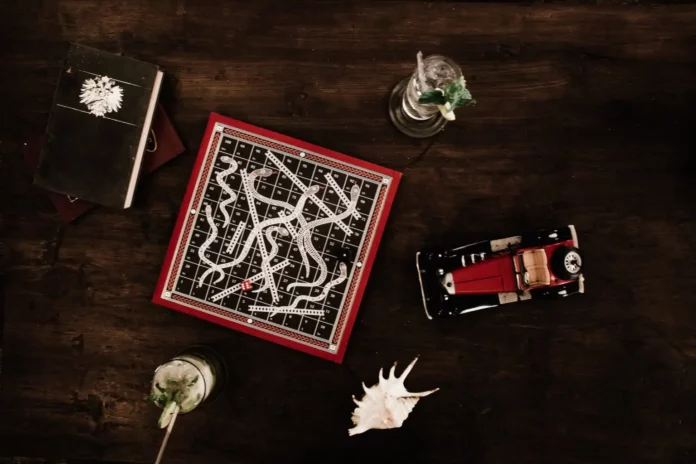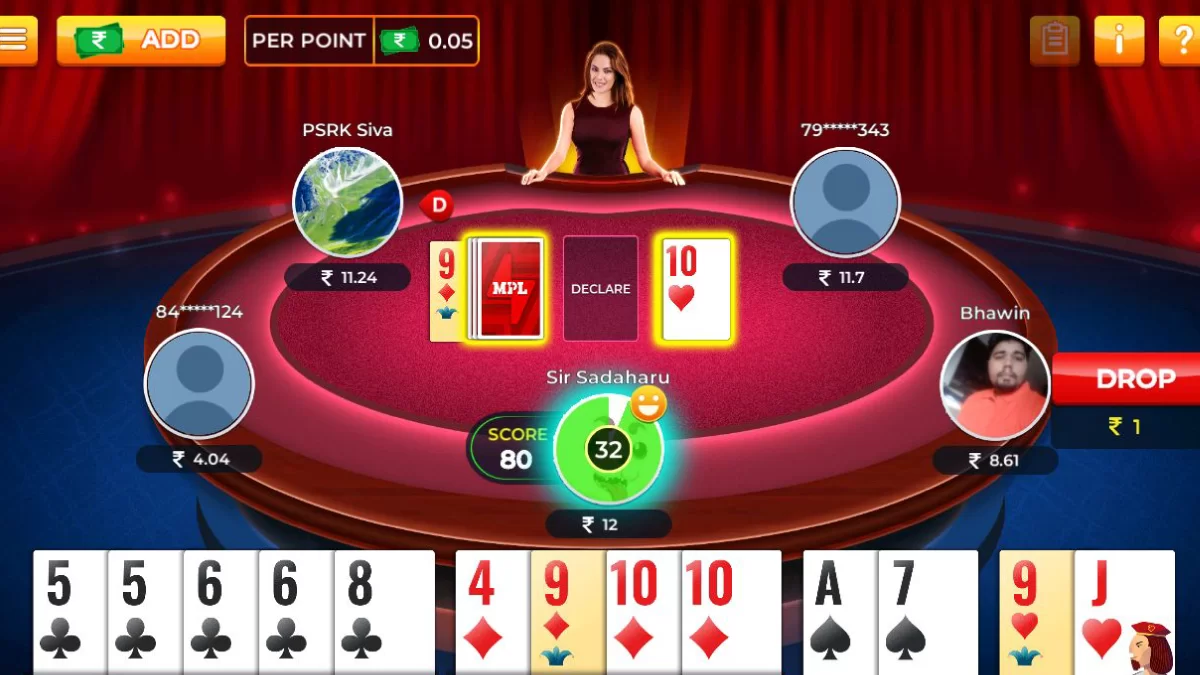The game that is a worldwide classic today has a rich history, and children, as well as adults, love it. Whilst the game has gained popularity all over the world, its history is obscure. As a matter of fact, it is a game that originated in ancient India. It was not just about entertainment but had moral and religious aspects to it too.
Who Invented Snakes and Ladders?
The game today called snakes and ladders was called moksha patamu or originally called Mokshpat. It is not exactly known who invented the game, although some historians believe Saint Gyandev came up with it in the 13th century AD. Some also believe that the game existed as early as the 2nd century AD.
Along with Ludo, other dice board games like Snakes and ladders have also made their mark in the most popular category game.
The Game of Knowledge
The gameplay of Gyan Chaupar is similar to the Snakes and ladders game; however, the intention of the original Indian game is quite different. The number of squares that Gyan Chaupar had differs from that of Snakes and Ladders. One version of this board game has 72 boxes, while another has 100. Another significant difference between both the games is that Gyan Chauper(the original Hindu game) has the representation of good deeds versus evil, the ladders representing virtues, and snakes representing vices. The modern game has no such connotations.
In an Indian Gyan Chaupar, there is a board of 72 boxes, and the squares numbered 24, 44, and 55 have the vices of bad company, false knowledge, and ego, respectively. As the game emphasizes karma, the Hindu principle of cause and effect, each vice (the snakes’ heads) has a corresponding effect. Thus, for the vices mentioned above, the related effects are conceit or vanity, the plane of sensuality, and illusion.
The virtues, on the other hand os pne of purification, true faith, and conscience are contained in squares number 10, 28, and 46, and these lead to the heavenly plane, the plane of truth, and happiness, respectively. In this version of the board, the goal is to reach box number 68, which is the plane of Shiva.
Snakes and Ladders as a Religious Teaching Tool
The game is gained major popularity that is adapted in the entire Indian subcontinent. This game has an adaptation in Jain, Buddhist, and Islamic religions too. The game has the values of cause and effect, value and virtue. This game paved the way as a part of moral instruction without using conventional books or lectures.
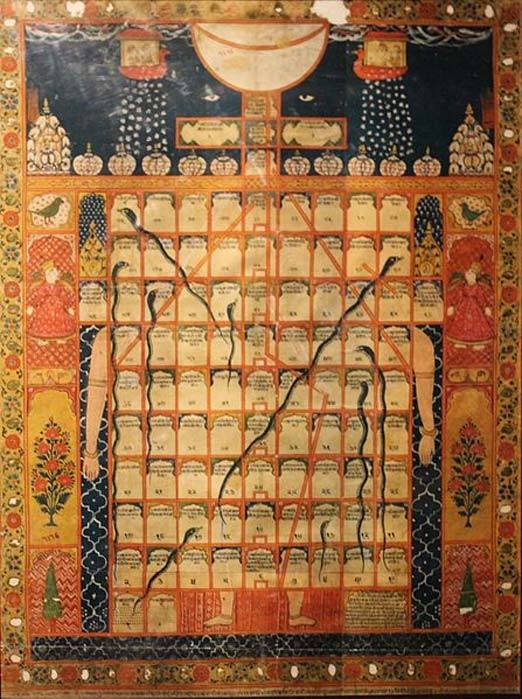
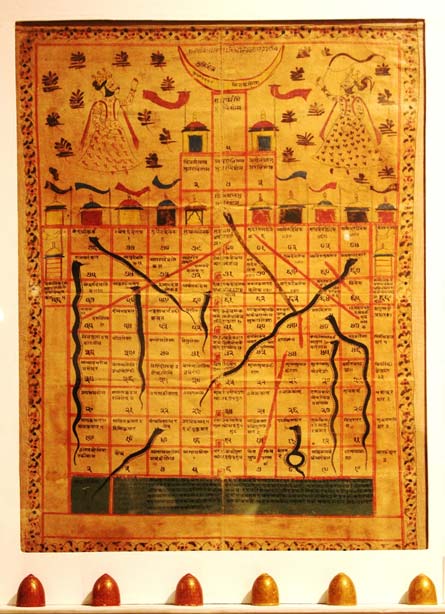
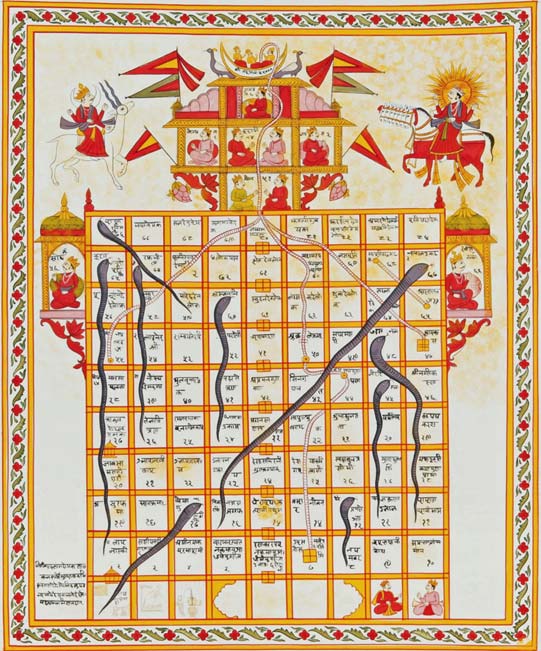
Jain version Game of Snakes & Ladders called jnana Bazi or Gyan Bazi, India, 19th century, Gouache on cloth.
The Modern Snakes and Ladders Game That We Know Today
The modified game of Snakes and Ladders that we know today came towards the end of the 19th century when India’s colonial rulers introduced it to Great Britain. The original gameplay was maintained, but its morality lesson doesn’t surface. The specific board squares were not of significant importance. There was no phenomenon where the ladders represented virtues and snakes represented vices.
Additionally, the number of snakes and ladders was equal, while in the older version, snakes outnumbered the ladders. This symbolizes the belief that it is far easier to fall prey to vice than to uphold virtue. From Great Britain, the game traveled to the United States, introduced in 1943 by Milton Bradley as Chutes and Ladders.
By the time Frederick Henry Hayes, the famous toymaker from Aldgate, London came up with the patent in 1892, the moral and religious aspects of the game were gone. There are some examples in Victorian England that were rooted in Christian morality encoded in the boards. The game, has other local variations such as “Moksha Pat,” “Paramapada,” “Sopanam” and other adaptations such as the Bengali “Golok Dham”and the Tibetan “Sa Nam lam sha”).
The Victorian versions of the of the game is the “Kismet”board game (ca 1895), now in the Victoria and Albert Museum’s collection. There were other similar games, such as “Virtue Rewarded” and “Vice Punished” (1818) and the “New Game of Human Life” (1790), although the latter did not have snakes and ladders on its board.

The Game’s Karmic Journey
In the Indian versions, it was not a racing game as it became in its Western adaptations. The game’s origins, which was in India had a very different meaning. It was a game that people could play again and again until they reached Viakuntha (the sacred domain of Vishnu) after completing many rebirths and corresponding human experiences.
Further discoveries in the British Library’s Archives led to two game boards and how an Indian game that emphasized destiny and to teach children the values of karma and religion became the Snakes and Ladders we know today.
The oldest “Gyan Chaupar” boards have is now in the British Library (Topsfield 1985, 203-226), initially in the posession of the East India Company officer Richard Johnson (1753-1807). Originally the game had its origins in the “Kridakaushalya”section of his 1871 Sanskrit magnum opus Brihad Jyotish Arnava. Like mentioned before, researchers from Aurangabad state that the game was invented by the Marathi saint Dnyaneshwar (1275 – 1296).
It further suggests that there are around forty-four game boards that date back to the late 15th century and ones that have 128 squares, 84 squares, or 100 squares instead of the 72 squares
There is, however, another board in the British Library that has probably not been written about yet. Listed as the “Paramapada Sopanam Pata,” it is described in the catalogue as:
Paramapada Sopanam, in which the highest ascent indicates reaching Heaven and anywhere else where the pawn lands indicate various worlds according to Hindu mythology. Language note: In Kannada and Devanagari.
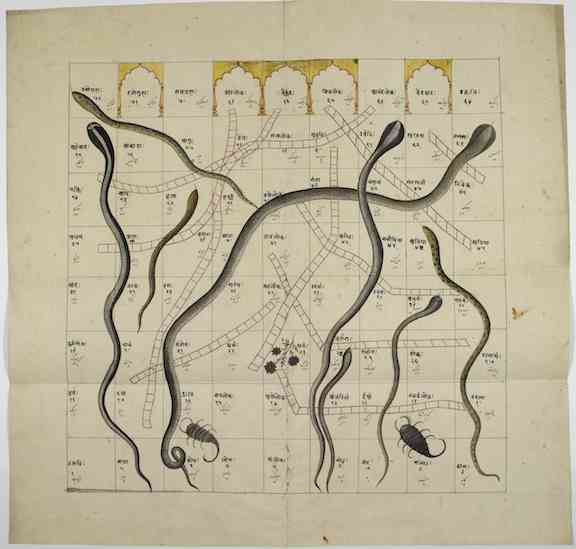
Around 1832, Captain Henry Dundas Robertson would present what he called the “Shastree’s Game of Heaven and Hell“ to the Royal Asiatic Society in London, where the 128-square Vaishnav Gyan Chaupar board can still be seen.
Around a century before Dampier and fifty years before Robertson, Richard Johnson’s possession of a “Gyan Chaupar” board around 1780-’82 is a rather strange one. This board is now part of the British Library’s collection. Johnson was the deputy resident at Lucknow, was among the lesser-known Orientalists.
Johnson’s contribution to boardgame studies is no less significant than that of the other orientalists. The “Gyan Chaupar”board was in his possession a good century before the game was imported to the West and transformed into a race game.
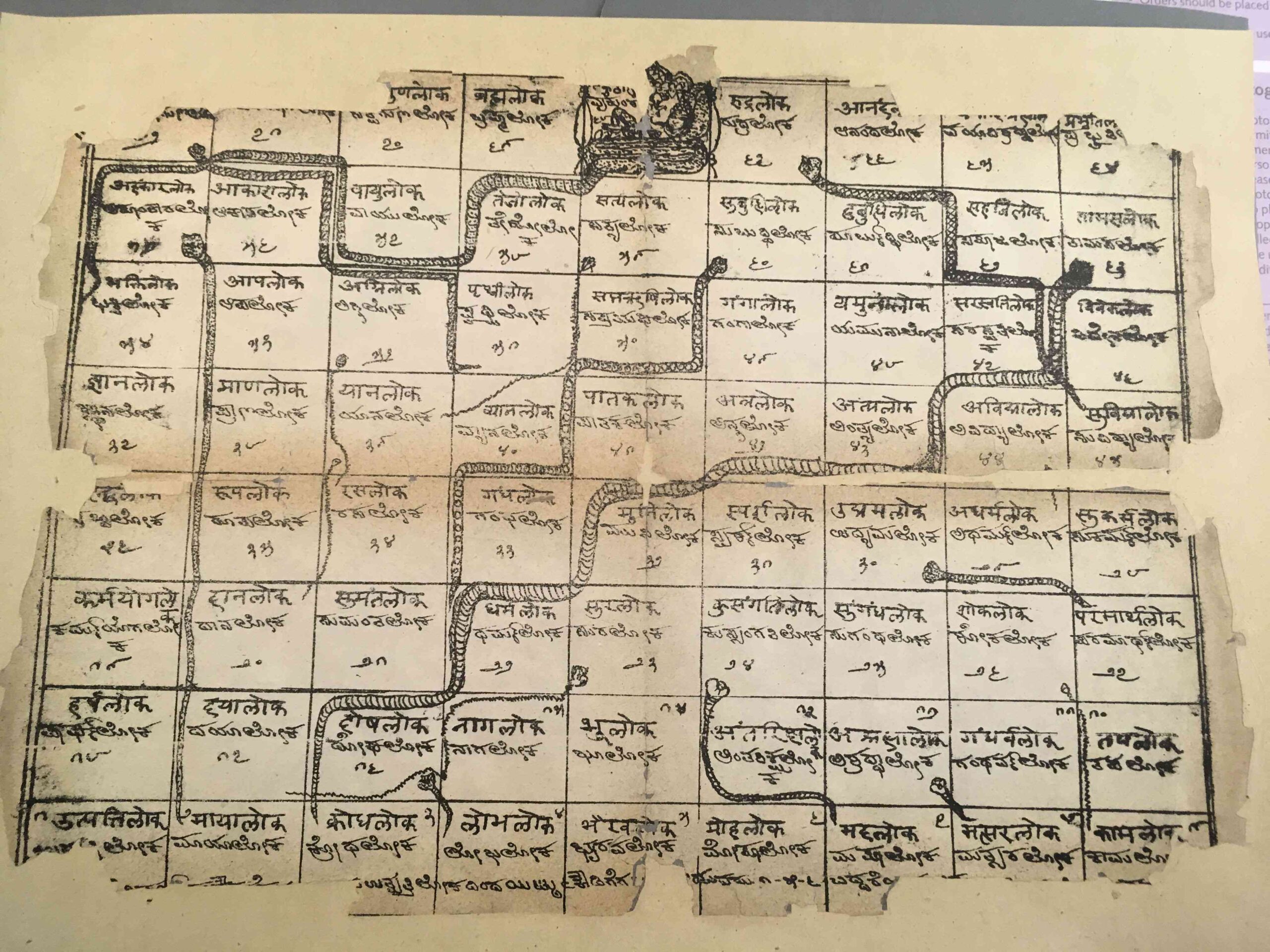
Snakes and Ladders- Roots in Bhakti Movement
Robert Johnson seems to have been interested in the original game, and besides the Devanagari script, each square also contains a Farsi transliteration. The words are not Persian, but the script indicates that it is. He got the words transliterated into Persian.
Two specific board squares have different meanings. Beginning the game on “utpatti”or “origin,” the player can move to “maya”or “illusion” (square 2), “krodh”or “lobh” – “anger” and “greed” respectively (squares 3 and 4) and ascend higher towards salvation via the ladders in the squares that represent “daya”or mercy (square 13) or “Bhakti”or devotion (square 54). Bhakti will take the player directly to Vaikuntha and salvation from the cycle of rebirths, and the game ends here.
FAQs
Can I play Snakes and Ladders online?
You can play Snakes and Ladders online in your web browser. This is a classic board game you can play for free, either as a single-player or multiplayer. Definitely try the Snakes and Ladders game on MPL.
Do you always have to roll a 6 to start Snakes and Ladders?
Each player places a token on the starting square on the board to start the game. Then, everyone rolls the dice and the player with the highest roll goes first. On your turn, roll the dice and move that number of spaces. If you land on the bottom of a ladder, climb up the ladder to the space at the top. You can play it with two or more players.
What will happen if you get a 99 on the snakes and ladders board?
You can only win by rolling the exact number you need to reach the last square. For example, if you are on square 99 and roll a four, move your game piece to 100 (one move), then “bounce” back to 99, 98, 97 (two, three, then four moves.) If square 97 is a ladder base or snakehead, climb or slide as usual.


